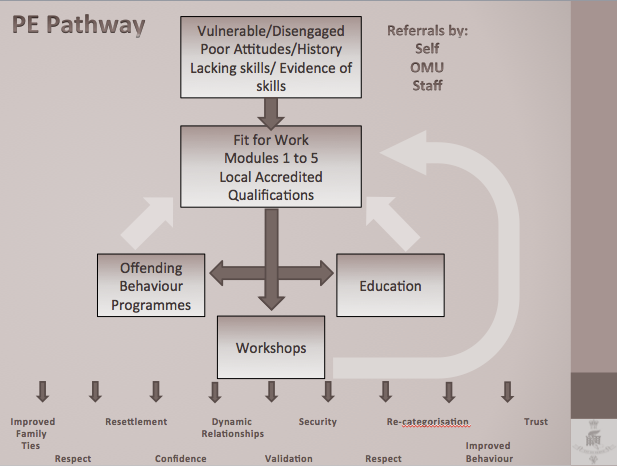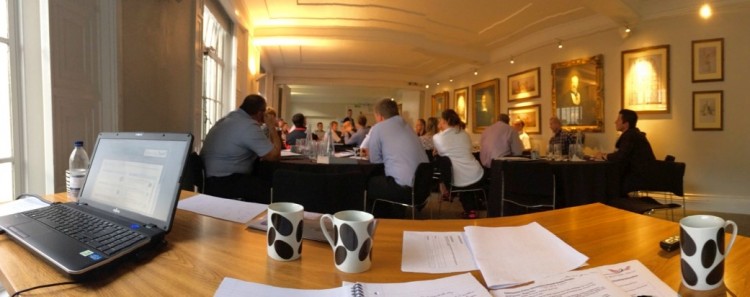Transforming Prisons & Prisoners Through Physical Education
Transforming Prisons & Prisoners Through Physical Education
This workshop, run by The Butler Trust in association with NOMS, focused on sport and PE in prisons, and the contributions they can make to healthy prisons and effective rehabilitation.
[For further examples of good practice in this area see the PE, sport and exercise interest group on good-practice.net.]

A Long History
The many benefits of physical education have been known and commented on for thousands of years. Indeed, the famous line by the first century Roman poet Juvenal, mens sana in corpore sano – ‘a healthy mind in a healthy body’ – is still widely quoted today.
Anyone working in physical education will have countless personal examples of the gains, great and small, in the behaviour and health of their students in the gym or on the playing field.

The expert group of Physical Education Instructors (PEIs) and others who gathered for the Butler Trust’s second workshop this year knew all this, of course, but also recognised a range of complexities in their work locally and nationally. After a series of presentations, some clear outstanding needs were identified, including a desire for better networking opportunities among the sector, and a greater use of evidence-based approaches to help facilitate enhanced support and resources locally and nationally.
The Presenters
Jon Carney and Carl Hardwick of the PE Services Operational Services and Interventions Group in NOMS, began the day with a detailed overview. Carl started by outlining the many benefits of PE for prisoners, from general health outcomes and offering a ‘route in’ for otherwise problematic offenders, to specific benefits regardless of age or ability. Several beneficial impacts of PE were noted, including slowing the progression of disease, reduced obesity, improved sleep, and opportunities to address smoking or substance misuse. “The healthy mind” in the healthy body aspect was also highlighted – in particular the way PE can help reduce depression and anxiety, relieve stress and, more generally, provide a positive environment for social interactions.
The benefits of PE for prisons overall are well attested, including a safer environment with improved discipline, order and control, and violence reduction and diversion. PE is also seen to foster better relationships within prisons and offers a series of knock-on benefits like better education and training outcomes, as well as programme completions.
The key challenges include resource constraints affecting staffing levels and equipment availability, cross-deployment of officers away from the PE environment, staff turnover, and the consequences of the reorganisation of staff structures, as well as what Jon and Carl’s presentation called “Mixed messages, different interpretations (local and Region/HQ) of the PE Service Specification and policy delivery requirements.”
The policy-led drive for evidence, for example derived from PE Performance Data, is additionally frustrated by resource constraints and by real practical difficulties in following up what are often inspiring case histories. For example, it can be almost impossible to track offenders after they have left prison, although it is known anecdotally that many are leaving with a sophisticated array of advanced PE qualifications which have helped them go on to engage in productive work as a direct result. Further, expertise in physical education has not historically been strongly associated with a knack for rigorous data collection – which the ‘evidence based approach’ demands – although as in sport more generally, this is changing. [view Jon and Carl’s presentation]
As the NOMS’ presenters noted, there are many examples of outstanding and innovative practice in PE across the country and Nigel Hayward of HMP Swaleside gymnasium provided an example of just that. Swaleside gymnasium’s ‘Discrete Education’ project had strong resonances with the Butler Trust’s previous workshop on Learning Disabilities. Swaleside’s staff already offered PE-related training to a high standard, but saw a major opportunity to extend that. Some pupils, working on vocational PE, were clearly struggling educationally, and yet were reluctant to go through the usual education route – for example because they didn’t want to be seen to need remedial education. Staff realised that such learning difficulties were proving a demotivating barrier to educational progress.
Working in concert with the education department, staff developed a discrete educational programme based in the gym (which also made it discreet). The approach was deliberately designed to cascade out into the prison, and to rebrand the education process in general. So, for example, the gym has become a ‘Sports College’. Essential skills in literacy and numeracy are now firmly embedded in PE teaching.
 The project worked with the Prisoners’ Education Trust, and their Head of Policy Nina Champion, who visited Swaleside to see it in action, was impressed, which has led to a short film called Embedded Learning which focuses on Swaleside, along with other examples such as a book project at Reading.
The project worked with the Prisoners’ Education Trust, and their Head of Policy Nina Champion, who visited Swaleside to see it in action, was impressed, which has led to a short film called Embedded Learning which focuses on Swaleside, along with other examples such as a book project at Reading.
Swaleside have cleverly used the attractiveness of gym access, a simple but effective rebranding, along with shorter and less demanding lesson periods, to help embed learning opportunities across the prison.
One student, expelled from school at 14 and unable to read or write, complained that people would “take the mick out of me and I’d always get into trouble because of it.” Having engaged in the programme, he now describes himself as “hooked on education.”
It’s a natural habit for physical educators to focus on both individual and team motivation. Combining this with their status among prisoners, and their role as gatekeepers to gym access, clearly makes for an excellent fit with education more widely. Those attending the workshop collectively responded strongly to this approach, immediately recognising how this work built on their existing strengths.
[view Nigel’s presentation]
 Andy Small at HMP Huntercombe described how he had helped develop the profile and perceived importance of PE within the prison. In order to reduce the daily frustration of PE staff redeployments, his team set out to change management perceptions. A combination of approaches, including training and education, and a prestigious Royal College of Psychiatry Enabling Environment Award, helped increase understanding of the valuable contribution PE made in the prison. Impressive results have included 90% of prisoners’ attending the programme, reduced redeployments, and an impressive number of ex-offenders entering the fitness industry. [view Andy’s presentation]
Andy Small at HMP Huntercombe described how he had helped develop the profile and perceived importance of PE within the prison. In order to reduce the daily frustration of PE staff redeployments, his team set out to change management perceptions. A combination of approaches, including training and education, and a prestigious Royal College of Psychiatry Enabling Environment Award, helped increase understanding of the valuable contribution PE made in the prison. Impressive results have included 90% of prisoners’ attending the programme, reduced redeployments, and an impressive number of ex-offenders entering the fitness industry. [view Andy’s presentation]
Anastasia Selby of HMP Thorn Cross, a Category D prison in Cheshire for young offenders, described how their approach had built extensive relationships with sports and leisure industry organisations beyond the prison walls. Thorn Cross courses range from First Aid to the Football Association’s Level 1 Coaching course, and they run regular prisoner and staff ‘health days’.
Increasing employment opportunities is a key element in the work, and former prisoners are now working in the gyms of a local hotel group. Prison mentors have also given talks in the local community, and an excellent relationship with Manchester City football club has led to other offenders taking part in the club’s ‘success through sport’ programme. Positive relationships developed there in turn led to sub-contractors on MCFC’s Etihad Stadium opening up opportunities for ex-offenders to work as bricklayers. The program has also built strong connections with other local cricket and rugby clubs. [view Anastasia’s presentation]
 The sheer power of sport and physical education as an enabling environment for all ages was ably demonstrated by Nigel Lambert of HMP Wakefield. Wakefield has one of the oldest prisoner profiles in the country, and staff there recognise that an approach especially adapted to the needs of older people was needed.
The sheer power of sport and physical education as an enabling environment for all ages was ably demonstrated by Nigel Lambert of HMP Wakefield. Wakefield has one of the oldest prisoner profiles in the country, and staff there recognise that an approach especially adapted to the needs of older people was needed.
Recognising that the gym offered a safe space for sports and games, as well as social activities and informal interactions supervised by PEIs, the Wakefield approach built a series of tailored interventions. To address concerns around the onset of Alzheimer’s and dementia, games that stretched people mentally – like Scrabble, crosswords, and wordsearch puzzles – were introduced. Another focus involved working on cardiac health, with a 15 week programme for prisoners with heart problems. As well as tests at each session, specific exercise plans were designed to build heart strength which included recovery periods before offenders were allowed to return to the wing.
A particularly inspiring element of the Wakefield approach is the use of ‘Wing Carers’. This group of volunteer prisoners are helping elderly and disabled prisoners with everyday tasks, thus improving the quality of their lives. Wing Carers sign a ‘Carers Duties Compact’, engage in Health & Safety training, and commit to a programme of caring for up to four prisoners depending on needs. Nigel sees the most important initiative for HMP Wakefield in the coming year as achieving ‘a rehabilitation culture’ and ‘the restoration of hope’. [view Nigel’s presentation]
Finally Phil McVay and Paul Walters of HMP Frankland outlined Fit For Work, a five module approach to using physical education as a pathway to employment opportunities. The modules are: Improving Performance & Productivity, Self Management, Motivation and Goal settings, Healthy Lives, and Practical Leadership. Modules are run in the morning, with the first half classroom-based, before moving on to practical work. Each module involves around ten PE and 3 educational sessions. The final result is accreditation, for example Level 1 Employability Skills.
The detailed modules are available in the presentation and are impressive. The many benefits of their approach – and, indeed, of PE in prisons in general – are captured well in their final slide [view Phil and Paul’s presentation]:

Breakout and discussion
It’s perhaps unsurprising, given the powerful role of teamwork in all sports, that there’s a notably strong sense of camaraderie among Physical Education Instructors, and the workshop participants were a clear example of this. Butler Trust Director, Simon Shepherd, frequently mentions, in the context of his own background working in the prison system, the enduring and impressive capacity of so many people in the sector to identify problems, to step forward with solutions, to find workarounds – often in the face of resource constraints or other trying blockages – and to make good things happen.
The PEI cadre are a shining example of exactly that. At the start of the workshop they already knew quite how motivating and life-changing PE can be for those who may struggle in a variety of ways. The workshop offered a coherent set of further examples.

That said, they also knew that they needed to get better at presenting a research-led business case to management in order to secure better and more intelligent resourcing and support. Further, they realised that their experience was remarkably similar, and that networking events were a powerful way to share and build further on their respective expertise.
One thing that delegates did ask for is a summary of the key research about the impact that sport and PE can have in prisons, which they could use to inform their own practice, and also to show to senior managers in their establishments. Since the workshop, the Butler Trust, in consultation with the author, have pulled together a short paper summarising the book “Sport in Prison”, by Prof Rosie Meek, of London University. [Sport in Prison – summary].
[For further examples of good practice in this area, see the Knowledge Exchange.]
